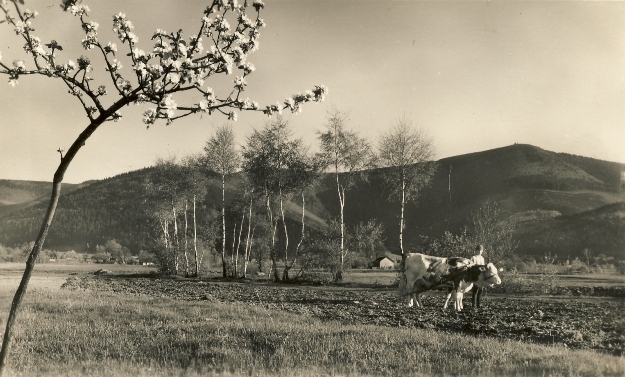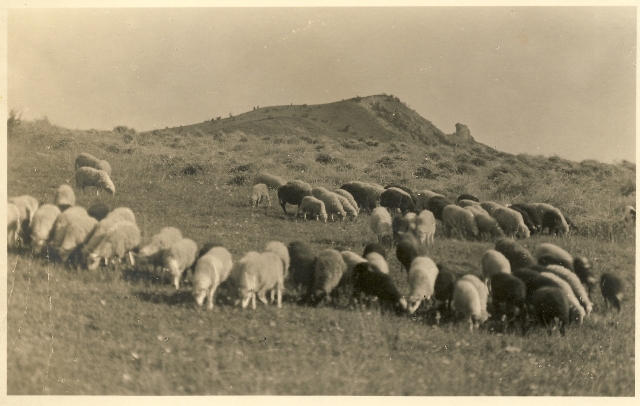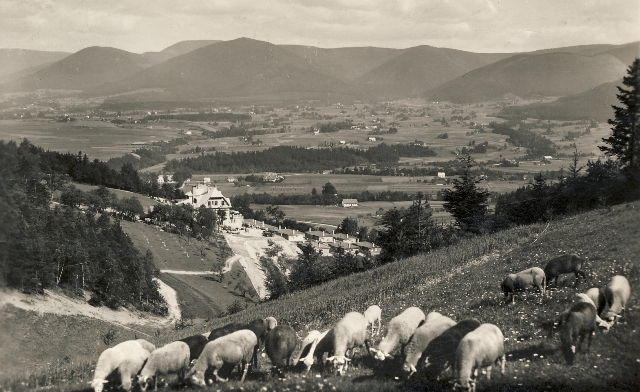The Hukvaldy authorities brought Trojanovice into existence in a long-term colonization at the beginning of the 16th century. New inhabitants were invited to clear forests and carry on mountain farming. The settlement was proclaimed an autonomous village at the request of its dwellers – wood-cutters, mountain farmers, ore miners, charcoal burners and forest clearers living below Mount Radhošť. The first colonists below Radhošť were the Slavonic people, as is reflected in the oldest names of local mountains, hills and streams – Radhošť, Hradisko, the Lubina River and other. It was also the period which gave rise to the local mythology, legends, stories and tales about Mount Radhošť and the mythic character Radegast.
Wallachian Colonization
After 1200, German colonists arrived in the area. They built the stone castle of Hukvaldy which became the centre point of the whole region. The Hukvaldy gentry encouraged the so- called Wallachian colonization and granted permission to shepherds coming from the east to settle in the mountains on the periphery of the domain. In time, the shepherds settled down and built cottages in the clearings. Their dwellings were built in the Carpathian style – wooden cottages with stone bases and decorated gables. It was not until the 19th century that the settlements were rebuilt with the use of clay bricks.
There were two aspects to the Wallachian colonization, a positive and a negative one. Both of them were the result of the historic situation. The positive aspect is connected with the Wallachian idyll of a serene and happy life in the free and pure nature in the heart of the mountains. The Wallachian rebellions show the darker side of Wallachian life, in which the liege people were at the mercy of foreign masters and frequently had to fight for their freedom with weapons and sacrifice their lives. However, the rebellions brought forward positive characters of rebels, outlaws and folk heroes. By their revolt against the Habsburgs during the Thirty Years’ War the Wallachians entered the national and European history. Since then, Moravian Wallachia has been perceived as a revolutionary and to some extent ethnic unity. Thus the Wallachian colonization generated not only local folklore, its songs, dances, tales, customs, architecture and terminology, but also the awareness of liberty and free life, bonds of brotherhood in weal and woe, in times of peace as well as in times of war.
The Beginnings of Autonomy
The beginnings of the community’s self government may be dated to 1560, when the sheep farmers were headed by the Wallachian prefect in Kozlovice and by chief shepherds. The shepherds in the sheep huts organized production and were responsible to their first-line supervisor – the prefect.
The Second Step to Autonomy was taken in 1677, when the dwellers in the clearings (about seventy people) were freed from all town corvee with the exception of the so called “wood corvee” which they had to do until 1675.
The Third Step to Autonomy was made by establishing the position of the mayor, who was to be the steward of the Paseky settlement (later Trojanovice). It occurred some time after 1720. In that year a settlement for iron-millers was founded in the neighbourhood of Bystré, and at the same time new stable centres of sheep farmers were established on Mount Radhošť, at Mjaší and at Horečky. To that date the number of inhabitants reached over one hundred. In 1733, the most prominent mayor of the period, Antonin Bača-Horečka, rented the top of Mount Radhošť from the authorities for 16 gold coins a year. He lived at Horečky and according to the records he influenced the beginnings and forming of the village self-government.
Final Step to Autonomy came in 1748, when the office of the reeve was established. Laying out the boundaries and establishing the clearings was not a simple process – there were bribes, imprisonments and even dead people recorded. The disagreement between Hukvaldy Castle and the town of Frenštát grew into a law-suit. The town lost the case despite the bribe of 1,000 gold coins. The authorities granted suit to the numerous requests of the clearings dwellers for autonomy in 1748. In that year Ferdinand Troyer, the landlord, ordered his secretary and the local game-keeper to lay out the boundaries of the self-governed village. They took six week to finish the task. The boundaries were adjusted several times before 1833, since then they have not been changed.
Grounds for autonomy were drawn up by the office of F. J.Troyer and sent to Vienna. The document states that “the clearings dwellers have cleared the seigniorial forests damaged by iron-mills and glass-works and changed them into fields.” The reasoning is most remarkable and probably very uncommon in the feudal era. In older times and in other locations settlements were traditionally established on green ground. agricultural soil. The situation was different in our region. People had to cultivate the soil first, till and sow it and only then could they get their freedom.
The Name of the Village – The newly established village was to be named after its landlord – Troyerovice. The dwellers pronounced the name Troyer as Trojar and, even more frequently, Trojan, and since 1750 all written records use the Trojanovice version.
1748 to 1848 – the Century of Reeves
The office of the reeve in our lands dates back to 1200. The reeves held considerable powers. They could inflict the punishment of stocks, shackles and imprisonment. In Trojanovice they had the help of four beadles and twelve aldermen. They carried out their duties from their home – the reeve’s house. Eleven reeves worked in turns in Trojanovice. Florian Šrubař, the third reeve in the office, is especially worth mentioning. He supported building of houses and is connected with the beginnings of recreation in the area. The eighth reeve. Matuš Tichavský, introduced teaching in the houses and himself taught in his own house, so he belongs to the first village teachers in Trojanovice. The last, eleventh, reeve was František Hilšer, nicknamed Valchař (Fuller). He was famous for his hearty sense of humor that he used when he was fighting against the oppression and the bureaucracy of the authorities. He is probably the most notable personality in the Hukvaldy countryside of the 19th century. He has even been mentioned in the broadside ballads, where we learn that Valchař had tried to mine black coal close to his house, until the authorities put the seal on his mine. The century of reeves is typical of great growth of the village population: while there were 800 to 1,000 inhabitants in Trojanovice in 1748. when the village was established, one hundred years later the number reached almost 2,500.
1848 to 1945 — the Century of Mayors
The office of the mayor was introduced to the villages in 1849. They were responsible to county marshals and had fewer powers compared to the reeves. Karel Kocián, the third of the mayors, surpassed the average – he succeeded (with the help of some more civic-minded neighbours and encouraged by the provincial congress in Brno) in putting through the idea of a village school. The buildings were not constructed until the fifth mayor, Josef Chovanec, assumed the office, though. Josef Malý, the eighth mayor of Trojanovice, who was the first mayor to move his office from his home to the school, is worth mentioning as well. His decision was very important, because the amount of routine work increased during the war, particularly due to the introduction of ration cards and the office had to take on another clerk. Josef Malý also proved very competent in the turbulent war years, when he bravely stood up to the fascists. In the beginning of the century of mayors the number of inhabitants reached its peak with 2,541 in 307 houses in 1857. In 1890 the population dropped to 2,030 people living in 346 houses. The decrease was caused by high poverty and very lean harvests in the period of 1846.1856. A great number of Trojanovice villagers left to seek better living in the USA, Brazil or New Zealand. The population grew to 2.500 around 1945, but it was followed by another wave of emigration, this time to the border regions. 524 people moved out from Trojanovice, mostly to Rudoltice in Silesia.
The Period of People’s Committees 1945-1990
The period of people’s committees represents the recent history and temporary end of self-government in Trojanovice. The committees were political bodies that changed the long working social and eco-nomic system. The descendents of the clearings dwellers who cleared the forest with their own hands were forced to join the collective farm (United Agricultural Cooperative – JZD) and hand over their property. They had to hand the property over to the collective farm even when it was in debt, yet they were left the pay the debts. Thus the villagers often had to watch strangers stealing and destroying their former pro-perty. Those who had a bigger farm had to accommodate alien people and were frequently left with a single room for their own family. It was the period of building and development – the village was electrified, roads were tarmaced and the system of sewerage was started. Troja-novice opened a cinema, built a number of new recreational facilities and Co-op shops. The construction was carried out in the system cal-led “Project Z”, sometimes without much regard to quality of work or the traditional architecture. Too much benevolence was also shown to builders of residential houses: building permissions were given to designs that did not fit into the landscape character.
Development of weekend cottages left another permanent scar on the countryside. The unfortunate period culminated in connecting and straightening of the former “salt roads”. Joining them into one straight road – Solárka – made Trojanovice a through-traffic village. The megolamanic project of opening the Frenštát Mine below Kozinec meant the final disaster for Trojanovice.
However, the period was very rich as to culture and social life. The villagers founded the LUT (Folk Art Creativity) ensemble Radhošť; the beauty of Trojanovice was pictured with great success by the Strnadel brothers – Antonín, Josef and Bohumír (his penname was Četyna) and another native of Trojanovice, Jan Knebl, their uncle. To commemorate their work the community built and opened a memorial hall in 1989. The hall includes a common room, where public gatherings, social events, weddings and similar happenings take place. Population growth in the period of people’s committees registered only a minimal change: from 2,000 people in 1948 it grew to 2,030 in 1990.
Back to the Mayors in 1990
Autumn 1989 proved the untenability of the socialist system and ended functioning of people’s committees commanded by the Communist Party. People can vote without restraint: property returns to the hands of private owners, regrettably very often in bad state and dilapidated. The continuity of mountain farming had been broken by forced participation in collective farming and very few descendents of the original farmers went back to working on their land. The history of the village was highly influenced by Mr. Drahomír Strnadel, the first mayor after the Velvet Revolution (four terms of office – 1990-2006). He has merit in attenuation of Frenštát Mine, in elimination of damages caused by the Russian military occupation, in introducing gas to village households and maintaining cultural traditions of the community. Drahomír Strnadel also has to be thanked for re-establishing contacts with the descendents of our countrymen who left Trojanovice in the years 1850 to 1900, mostly for Texas in the U.S.A.
New memorial tablets commemorate prominent citizens from the times of the First Czechoslovak Republic and the war period. The Monument to the Strnadel brothers and Jan Knebl was expanded by adding a new timber building, which made the place even more picturesque. Thanks to re-establishing Matice Radhošťská in 1994, when Mr. Jan Tichavský proved very helpful, the Chapel of Sts. Cyril and Methodius on Mount Radhošť could be fully reconstructed in the period between 1999 and 2005 (it was built in 1898). On the 3rd of November 2006 Jiří Novotný. M.A. became the second mayor.
Nowadays the village strives for further development particularly in the areas of civic amenities, sports facilities and tourist industry. In 2008 the Monument to the Strnadel brothers and Jan Knebl was fitted up with a new art gallery. Now the village authorities work on projects that should provide Trojanovice with a sewage system, sports grounds, a new Municipal house with a library, information centre and ceremonial hall. New cycle tracks and ski tracks are being built and the reconstruction of the sport and relaxation zone at Horečky is under consideration. The future of the village and the development of tourist industry in the Beskydy depend to a great extent on the state of mining activities connected with the Frenštát Mine. The current village council realises that and is taking steps to protect the region against any mining activities.
F. J. Troyer – the founder of the village
Ferdinand Julius, Count Troyer was born on the 20th of January 1698 in Innsbruck. His father. František Antonín, a Chancellor of Tyrol and chamber counsel, was ennobled in 1697. His mother was Maria Maximiliana of Teuffenbach. On the 11th of November 1711, Ferdinand Julius received the Olomouc canonicate and on December 25th 1720 he took orders. In 1731 he became arcidiakon in Opava and since 1714 he was a scholastic in Olomouc. When the Church authorities transferred bishop Jakob Ernest from Olomouc to Salzburg, Count Troyer was appointed bishop of Olomouc (9th December 1745) and took orders on the 22nd January the following year. In May he was appointed chamber counsel and on October 9th 1746 he obtained the title of Counsel Imperial. On April 10th 1747 Pope Benedict XIV appointed him cardinal. On the death of the Vienna archbishop, Cardinal Kollonitsche (April 12th 1751) Count Troyer was nominated Protector of Germania. Bishop Troyer endeavoured to bring about the canonization of Jan Sarkander, unfortunately he did not succeed: the process was interrupted by the Pope’s death. Bishop Troyer spent the years 1754-56 visiting the whole diocese. He had the Olomouc fortifications reinforced and three hunting lodges built on the outskirts of Vyškov; they were named Ferdinandsruh, Juliusburg and Troyerstein. In 1748 he established the village of Trojanovice as an award to the farmers in the clearings for their hard work. When the bishopric castle in Kroměříž burnt down in 1752, he donated large sums towards the restoration. Count Troyer died on February the 5th 1758 in Bmo and was buried in Olomouc.







